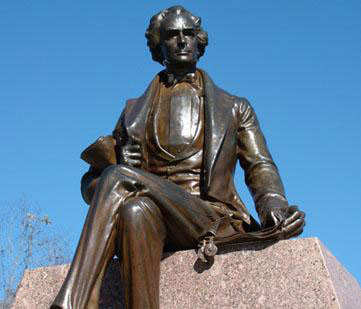Today@Sam Article
Archeology Month Speaker To Explore Austin Colony
Oct. 5, 2016
SHSU Media Contact: Jennifer Gauntt
When it was established in 1824, San Felipe de Austin became the social, economic and political center of the Stephen F. Austin Colony, eventually growing to become ranked as No. 2—behind San Antonio—as a commercial center in early Texas.
 |
| A statue of Stephen F. Austin at the San Felipe de Austin state historic site. —Image from the Texas Historical Commission website |
Ninety years later, the Texas Historical Commission’s archeological stewards began an excavation of the colony, focusing on Town Lot 566 where the Farmer’s Hotel was constructed between 1829 and 1830.
On Tuesday (Oct. 11), Bryan McAuley, the THC historic site manager for the colony, will share tales from the project in “The Untold Stories of San Felipe de Austin and How We Know What We Know.”
Sponsored by the Sam Houston Memorial Museum in celebration of Texas Archeology Month, the presentation will begin with a reception at 6:30 p.m., followed by the presentation at 7 p.m. in the Katy & E. Don Walker Education Center. Admission is free.
“He (McAuley) will share the exciting details about the new museum/visitor’s center to be built in San Felipe, discuss the latest archeological excavations and share interesting stories about the residents such as Celia Allen, free woman of color,” said Sandy Rogers, Sam Houston Memorial Museum volunteer.
Before Gen. Sam Houston’s retreating army during the Runaway Scrape in 1836, San Felipe de Austin was the site of many of Texas’s most important events during the Texas–Mexican Revolution.
“Stephen F. Austin governed his colony of immigrants from this site, and it was the home of one of the earliest newspapers in Texas, The Texas Gazette, in 1829,” Rogers said, adding that it also was the home of Gail Borden’s Telegraph and Texas Register, the unofficial journal of the Texas Revolution.”
Situated on the Brazos River on the Atascosito Road, the town was the home of many of Texas’s notable figures, including Josiah H. Bell, Noah Smithwick, Gail Borden, William Travis, Samuel May Williams and Father Michael Muldoon.
The Conventions of 1832 and 1833 were held in San Felipe, as well as the Consultation of November 1835, which established a Provisional Government for Texas.
“San Felipe served as the capital of the provisional government until the Convention of 1836 which met at Washington on the Brazos,” Rogers said. “In March 1836, Moseley Baker’s small force of Texians defended the river crossing at San Felipe allowing the town citizens to gather belongings before crossing the Brazos in the Runaway Scrape ahead of the advancing Mexican army.”
The THC’s excavation has revealed details about the town that historians previously had only read about, according to Rogers.
“While still under construction the building served as the town hall described by San Felipe resident Noah Smithwick in his memoirs,” she said. “As the town hall, it is thought that the Consultation in 1835 was held there.”
The structure was described as being 32 feet square with a brick cellar 6 feet deep, and the first season of excavations focused on attempting to locate the four corners of the hotel’s brick cellar.
“Additional excavations focused on the brick oven operated by Celia Allen and the courthouse,” Rogers said. “The oven was located at the Brazos River crossing and was used by the Mexican army as a battery for their cannon which they used to fire on Moseley’s force during the Runaway Scrape.
The Walker Education Center is located at 1402 19th Street.
For more information on the presentation, contact Rogers at 936.661.9882.
- END -
This page maintained by SHSU's Communications Office:
Director of Content Communications: Emily Binetti
Communications Manager: Mikah Boyd
Telephone: 936.294.1837
Communications Specialist: Campbell Atkins
Telephone: 936.294.2638
Please send comments, corrections, news tips to Today@Sam.edu
